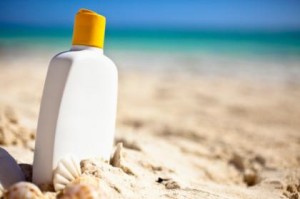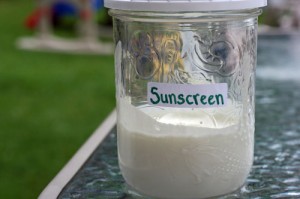 If you spend any time out in the sun, you should familiarize yourself with these sun safety facts.
If you spend any time out in the sun, you should familiarize yourself with these sun safety facts.
– More and more folks are adding umbrellas to their must haves for a day at the park or beach. Umbrellas can be deceiving by making you think that you’re safer than you really are. Up to 80 percent of UV rays can bounce off reflective surfaces such as sand, concrete and water, and reach you under the umbrella. Regardless of where you are outside… use sunscreen!
– Many medication, including some antibiotics, birth control pills, and antihistamines can make you sun sensitive. Always read the information sheet that comes with your prescription to see if the medication has a warning about sun sensitivity.
– Use the “shadow rule” as an easy way to help you gauge the strength of the sun. If your shadow is shorter than you, that means that the sun is at its strongest, as well as the UV index. On average the strongest time for the sun is between 11:00am – 2:00pm.
– Don’t forget to use sunscreen on small body parts. We often concentrate on arms, legs and backs, but forget places like ears, fingers, toes, back of the neck, and back of the knees. Heads need protection too, so wear a wide brimmed hat to help protect your scalp.
– Sunglasses protect your eyes and the delicate skin around your eyes from serious sun-damage, including eye diseases, cataracts and skin cancer. Make sure the sunglasses you pick are close-fitting and that they offer 99-100% UV protection.
– Even when it’s cloudy outside, you need to wear sunscreen. UVA and UVB rays are not filtered by the clouds or by shade – allowing about 80% of the damaging rays to reach the earth. When outside, always where sunscreen.
– Waterproof sunscreens and water-resistant sunscreens are different. On average water-resistant sunscreen gives you about 40 minutes of sun protection in the water, while waterproof sunscreen provides about 80 minutes. Regardless of which type of sunscreen you use, always re-apply after swimming.
– Don’t wait to apply your sunscreen till you have reached your destination. It takes about 15 to 30 minutes for sunscreen to sink into your skin and start working, so always apply sunscreen before you leave your home.
– The average life expectancy of a bottle of sunscreen – according to the expiration date is 2 years. However, sunscreens are often exposed to extreme heat, cold, and tops can be left open which can allow bacteria to enter the bottle which can destabilize the formula. To be safe, purchase new sunscreen every year.
– You can use clothing for sunscreen, but do your homework. A white cotton t-shirt provides an SPF of approximately 5 to 7, while a dark denim shirt with long sleeves can provide 100% protection. A good test is to hold your piece of clothing up to a light or window; if a large amount of light comes through the clothing, it won’t provide adequate protection. Consider hi-tech sun-protective clothing and accessories; many of them have a UPF rating (Ultraviolet Protection Factor) of 50 or higher.
So the next time you head outdoors, make sure you follow these sun safety rules.




